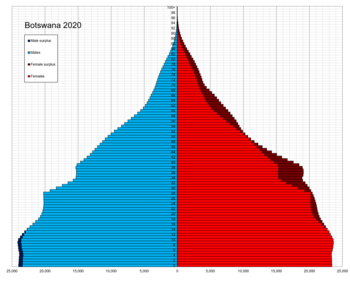
Back Население на Ботсвана Bulgarian Demograffeg Botswana Welsh Demografía de Botsuana Spanish Démographie du Botswana French 보츠와나의 인구 Korean Botsvanos demografija Lithuanian Демографија на Боцвана Macedonian Demografia do Botsuana Portuguese Население Ботсваны Russian Botsvana demografisi Turkish
| Demographics of Botswana | |
|---|---|
 Population pyramid of Botswana in 2020 | |
| Population | 2,359,609 (2022) |
| Growth rate | 1.4% (2022 est.) |
| Birth rate | 20.28 births/1,000 population (2022 est.) |
| Death rate | 9.05 deaths/1,000 population (2022 est.) |
| Life expectancy | 65.64 years |
| • male | 63.6 years |
| • female | 67.74 years |
| Fertility rate | 2.39 children born/woman (2022 est.) |
| Infant mortality rate | 25.18 deaths/1,000 live births |
| Net migration rate | 2.81 migrant(s)/1,000 population (2022 est.) |
| Age structure | |
| 0–14 years | 30.54% |
| 65 and over | 5.56% |
| Sex ratio | |
| Total | 0.92 male(s)/female (2022 est.) |
| At birth | 1.03 male(s)/female |
| Under 15 | 1.02 male(s)/female |
| 65 and over | 0.6 male(s)/female |
| Nationality | |
| Nationality | Motswana |
| Major ethnic | Tswana (79%) |
| Minor ethnic | Kalanga (11%) |
Demographic features of the population of Botswana include population density, ethnicity, education level, health of the populace, economic status, religious affiliations and other aspects.[1][2]

Botswana, like many nations in southern Africa, suffers from a high HIV infection rate, estimated among adults ages 15 to 49 to be 20.7%.[3]
- ^ "Botswana Demographic Survey 2017" (PDF). Statistics Botswana.
- ^ Statistics, Botswana (2015). Population Census Atlas 2011: Botswana. Library: Statsbots. p. 1. ISBN 978-99968-429-0-0.
- ^ "HIV & Aids in Botswana". AVERT International HIV & Aids Charity. 21 July 2015. Retrieved 27 January 2021.